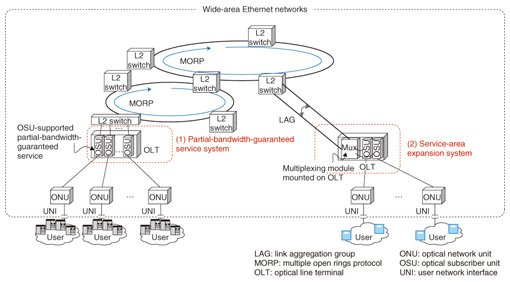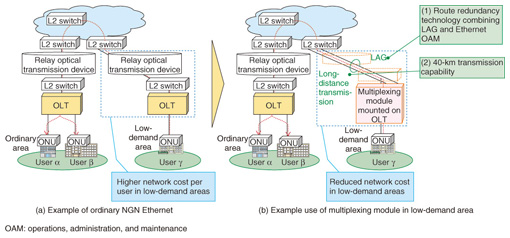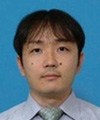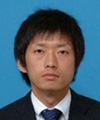 |
|||||||
|
|
|||||||
|
Regular Articles Vol. 12, No. 5, pp. 52–55, May 2014. https://doi.org/10.53829/ntr201405ra2 Advanced Technologies for Wide-area Ethernet NetworksAbstractThis article introduces a partial-bandwidth-guaranteed service system and a service-area expansion system that we have developed in order to improve the performance of wide-area Ethernet networks. The developed systems will enable new added services and provide a scheme for cost-efficient network expansion. Keywords: wide-area Ethernet service, partial-bandwidth-guaranteed service system, service-area expansion system 1. Wide-area EthernetWide-area Ethernet services have been commercially available since 2008 and have been providing high-speed circuit services at a reasonable cost compared to conventional leased-line services. NTT Access Network Service Systems Laboratories is doing continuous research and development (R&D) in areas such as L2 (Layer 2) networking technology and operating technology, with the aim of further advancing wide-area Ethernet networks [1]. Two requirements must be met in order to improve the existing NGN (Next Generation Network) Ethernet networks. - Offering various services that supplement datacenter/cloud needs - Sharply reducing network capital expenditure This article introduces a partial-bandwidth-guaranteed service system and a service-area expansion system that address these requirements by improving the access systems of wide-area Ethernet networks (Fig. 1).
2. Partial-bandwidth-guaranteed service systemWe have developed a partial-bandwidth-guaranteed service system that satisfies various customer needs (Fig. 2). Conventionally, wide-area Ethernet networks offer only bandwidth-guaranteed services. Therefore, there is unutilized bandwidth when the total contracted bandwidth is less than the physical bandwidth capacity of the network, or when the actual working bandwidth for forwarding user traffic is less than the contracted bandwidth. To efficiently utilize this unutilized bandwidth, we have developed a new system that achieves the transfer of user traffic as bandwidth-guaranteed traffic, as long as the user traffic does not exceed the predetermined guaranteed bandwidth. In addition, it can transfer the user traffic flexibly with the unutilized bandwidth even if user traffic exceeds the predetermined guaranteed-bandwidth limit. The system has the following three key functions.
(1) Bandwidth monitoring function This function supervises the flow of user traffic for every frame in order to determine whether to transmit traffic as guaranteed traffic or best-effort traffic. An optical subscriber unit (OSU) transfers the user frames that arrive under the designated committed information rate (CIR). User frames that exceed the CIR but not the peak information rate (PIR) are transferred by the OSU as best-effort traffic. If user frames exceed the PIR, the OSU discards them. (2) VLAN tag coloring function This function adds colored virtual local area network (VLAN) tags to user frames so that L2 switches can determine whether to use guaranteed class or best-effort class. The L2 switches refer to a class-identifier in the tag to execute the frame quality of service (QoS) control according to the congestion state. (3) QoS information identification function In the developed system, an access system determines the QoS class of the frame by checking the various designated priority fields in the user frames, which are arbitrarily set up by the user’s local policy, so that core switches can conduct QoS control according to the core network policy. Specifically, the OSU in the access system determines the color of VLAN tags according to the value of designated fields such as ToS (type of service)/TC (traffic class) for IP (Internet protocol) headers and CoS (class of service)/VID (VLAN identifier) for VLAN tags [2]. A wide-area Ethernet network that applies these functions can transfer even bursty traffic flexibly and efficiently according to the available bandwidth capacity in the network while keeping the conventional guaranteed transfer function. 3. Service-area expansion systemTo provide wide-area Ethernet service, it is necessary to establish an access network using several kinds of network equipment, for example, a media converter (MC), L2 multiplexing switches, and long-distance transmission systems. Conventionally, these multiple types of equipment have been applied to all service areas. However, in low-demand areas, the equipment cost per user becomes larger than in other areas (Fig. 3(a)). We have been working to reduce this cost and have developed a new multiplexing module for MCs that has a route redundancy capability and long-distance transmission capability. This module features a conventional multiplexing switching function that is integrated with a long-distance transmission function. This module adds VLAN tags to received user frames and multiplexes multiple access lines into one of the redundant trunk lines. This module employs the following two key technologies. (1) Route redundancy technology The system’s reliability is enhanced through the use of a novel route redundancy technology we have developed that combines LAG (link aggregation group) and Ethernet OAM (operation, administration, and maintenance) [3] ((1) in Fig. 3(b)). The active route is switched if the system detects a link down alarm in the physical layer or a frame loss in the data-link layer.
(2) Long-distance transmission technology This system makes use of a long-distance transmission module (ZX-SFP (small form-factor pluggable)) that has 40-km transmission capability over single-mode optical fiber ((2) in Fig. 3(b)). In addition, the system supports 1000BASE-SX (up to 550 m) and 1000BASE-LX (up to 5 km), which are standardized in IEEE 802.3, so that the operator can select the optimum SFP module depending on the distance between the L2 switch and the OLT. 4. SummaryWe have developed a partial-bandwidth-guaranteed service system and a service-area expansion system that promise to improve wide-area Ethernet services. These systems enable new added services and provide a scheme for cost-efficient network expansion. We believe these systems will open a path to further expanding the use of wide-area Ethernet services. References
|
|||||||















